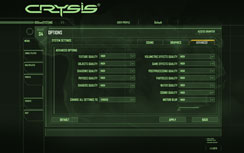Crysis
Publisher: Electronic ArtsWhat can we say about this game that hasn’t been said already? Crysis is probably the most anticipated game on the PC last year and was released on November 16th 2007.
Crysis is seen by many as the poster boy for DirectX 10 and it will make your system cry, quite literally – it’s a monster! It doesn’t come as much of a surprise then, that the graphics are something special – they’re above and beyond anything we’ve ever seen in a PC game.
We tested the game under both DirectX 9.0 and DirectX 10 with the 1.1 patch applied. We used a custom timedemo recorded on the Harbor map which is more representative of gameplay than the built-in benchmark that renders things much faster than you're going to experience in game. We found that around 30 fps in our timedemo was sufficient enough to obtain a playable frame rate through the game. It's a little different to other games in that the low frame rates still appear to be quite smooth.
For our testing under DirectX 9.0, we set all of the in-game settings to high, while we set shader quality and water quality to 'very high' for DirectX 10 -- all other settings remained the same as what they were set to for our DX9 performance testing. Because of how intense the game is, we tested with both anti-aliasing and anisotropic filtering disabled at resolutions above 1280x1024 for the time being. There is currently no support for anisotropic filtering in the game, but you can still force it from the driver control panel.
DirectX 9.0
DirectX 10
Nvidia’s GeForce 9600 GT is around 14 to 18 percent slower than the GeForce 8800 GT across our selection of test scenarios in Crysis under both DirectX 9.0 and DirectX 10 – the performance gap over the two different APIs remains pretty much the same, too.
The Radeon HD 3870 is also faster than Nvidia’s GeForce 9600 GT—the difference is around 15 percent under DirectX 10 with anti-aliasing enabled, while the same tests under DirectX 9.0 show just a two to five percent advantage for the 3870. With AA enabled, the 3870 is only around eight percent faster than the 9600 GT at 1280x1024 in DirectX 10, but in DirectX 9.0, the 9600 GT is 13 percent faster at the same settings.
Meanwhile, the 3850 is a bit slower still and is typically around seven to ten percent slower than the 3870. Interestingly, the GeForce 8800 GS really struggles in this title, proving that pixel throughput and memory bandwidth are very important when you’re running high detail in Crysis – it’s anywhere between 25 and 100 percent slower than the 9600 GT.

MSI MPG Velox 100R Chassis Review
October 14 2021 | 15:04











Want to comment? Please log in.